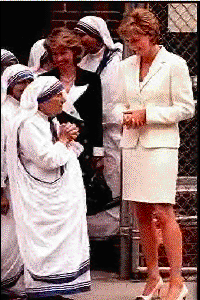
Enculturation, Vol. 3, No. 2, Fall 2001
![]()
Popular Icons and Contemporary Memory: An Apology, Year 2001
Apologia: An account of events, an argument offered in defense of a particular position.
Celebrities figure various styles of life and various views of society which anyone is supposedly free to embrace and pursue.
—Guy DeBord
 Two women in white and black, hands crossed, stand at a gated entrance. One clasps her hands fervently; the other loosely arranges her hands in front of her clean white suit. We notice two things: one woman is very small and is covered from head to foot in a linen sari; the other is a contrast, wearing a short skirt that expose her tanned, long, and lovely legs. Her feet are slipped into black and white high-heeled pumps. [1] She is bemused, laughing, looking down at the small woman to her right. The small woman looks not at her, but somewhere in the distance, as if searching for a word, or a prayer, or someone in the crowd that is not visible, but which we know waits beyond, in the space of the photographer. [2] Does the small woman, now recognizable as Catholic nun Mother Teresa, deliberately avoid our gaze? Does she refuse the camera's eye to resist the iconic status
that she knows will be conferred upon her? We know the other woman will look up. She is "shy Di," the English Princess Diana, who will turn her enchanting, media-hungry smile upon the press and the crowd in a moment. She will verify and ratify this moment with her look.
Two women in white and black, hands crossed, stand at a gated entrance. One clasps her hands fervently; the other loosely arranges her hands in front of her clean white suit. We notice two things: one woman is very small and is covered from head to foot in a linen sari; the other is a contrast, wearing a short skirt that expose her tanned, long, and lovely legs. Her feet are slipped into black and white high-heeled pumps. [1] She is bemused, laughing, looking down at the small woman to her right. The small woman looks not at her, but somewhere in the distance, as if searching for a word, or a prayer, or someone in the crowd that is not visible, but which we know waits beyond, in the space of the photographer. [2] Does the small woman, now recognizable as Catholic nun Mother Teresa, deliberately avoid our gaze? Does she refuse the camera's eye to resist the iconic status
that she knows will be conferred upon her? We know the other woman will look up. She is "shy Di," the English Princess Diana, who will turn her enchanting, media-hungry smile upon the press and the crowd in a moment. She will verify and ratify this moment with her look.
We wait. We are voyeurs. We look in on this scene from any point on the globe, through the electric eye of the internet. That it takes place in New York City, in America, far from the homes of either woman is irrelevant. We look into this scene from the past in the present, waiting for Diana to turn her head. Waiting for Mother Teresa to give some sign that they are both sanctified now after death, together, as the websites tell us, "in heaven."
1 | Next Node | 3 | 4 | 5 | 6 | Notes | Works Cited
|
Copyright © Enculturation 2001 |